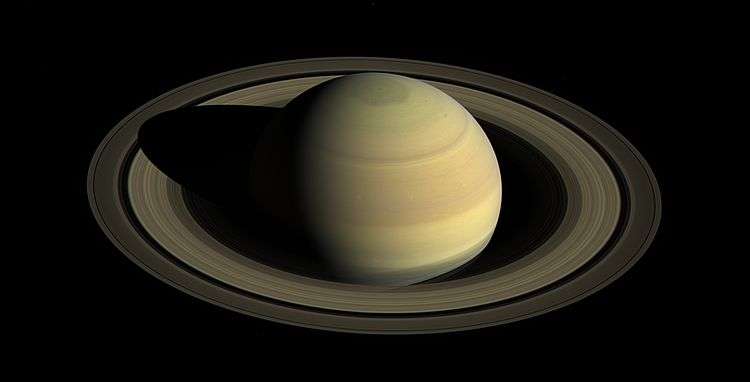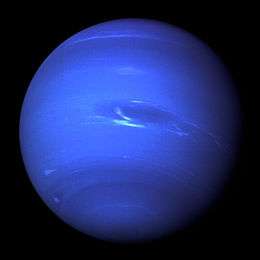List of missions to the outer planets
System Spacecraft |
Jupiter | Saturn | Uranus | Neptune | Pluto |
|---|---|---|---|---|---|
| Pioneer 10 | 1973 flyby | ||||
| Pioneer 11 | 1974 flyby | 1979 flyby | |||
| Voyager 1 | 1979 flyby | 1980 flyby | |||
| Voyager 2 | 1979 flyby | 1981 flyby | 1986 flyby | 1989 flyby | |
| Galileo | 1995–2003 orbiter; 1995, 2003 atmospheric |
||||
| Ulysses | 1992, 2004 gravity assist | ||||
| Cassini–Huygens | 2000 gravity assist | 2004– orbiter; 2005 Titan lander |
|||
| New Horizons | 2007 gravity assist | 2015 flyby | |||
| Juno | 2016– orbiter |
A total of nine spacecraft have been launched on missions that involve visits to the outer planets; all nine missions involve encounters with Jupiter, with four spacecraft also visiting Saturn. One spacecraft, Voyager 2, also visited Uranus and Neptune. The nine missions include two; Ulysses and New Horizons, whose primary objectives are not related to the outer planets, but which flew past Jupiter to gain gravity assists en route to a polar orbit around the Sun, and Pluto - at the time of its launch considered an outer planet - respectively. Cassini–Huygens also flew past Jupiter for a gravity assist on its mission to explore Saturn.
Only three of the missions to the outer planets have been orbiters: Galileo orbited Jupiter for eight years, while Cassini has been in orbit of Saturn since 2004 and Juno around Jupiter since 2016.
Jupiter
Six spacecraft have been launched to explore Jupiter, with an additional three spacecraft making gravity-assist flybys without the exploration of Jupiter being one of their primary objectives.
| Spacecraft | Launch Date | Operator | Mission | Outcome | Remarks | Carrier rocket |
|---|---|---|---|---|---|---|
| Pioneer 10 | 3 March 1972[1] | NASA United States |
Flyby | 4Successful[2] | Closest approach at 02:25 UTC on 4 December 1973[3] | Atlas SLV-3C Centaur-D[4] |
| Pioneer 11 | 6 April 1973[1] | NASA United States |
Flyby | 4Successful[5] | Closest approach at 05:22 UTC on 3 December 1974, later flew past Saturn[6] | Atlas SLV-3D Centaur-D1A[4] |
| Voyager 2 | 20 August 1977[1] | NASA United States |
Flyby | 4Successful | Closest approach at 22:29 on 9 July 1979, later flew past Saturn, Uranus and Neptune[7] | Titan IIIE Centaur-D1T[8] |
| Voyager 1 | 5 September 1977[1] | NASA United States |
Flyby | 4Successful | Closest approach at 12:05 UTC on 5 March 1979, later flew past Saturn[9] | Titan IIIE Centaur-D1T[8] |
| Galileo | 18 October 1989[1] | NASA United States |
Orbiter/Atmospheric | 4Successful[10] | Atmospheric probe entered atmosphere at 22:04 UTC on 7 December 1995 and operated for 57 minutes; main spacecraft entered orbit at 00:27 UTC on 8 December.[11] Spacecraft was deorbited on 21 September 2003, impacting Jupiter's atmosphere at 18:57:18 UTC.[12] | Space Shuttle Atlantis STS-34 / IUS[13] |
| Ulysses | 6 October 1990[1] | NASA United States / ESA |
Gravity assist | N/A | Flyby on 8 February 1992 to reach a high-inclination heliocentric orbit.[14] Also made a distant incidental flyby on 4 February 2004[15] | Space Shuttle Discovery STS-41 / IUS[16] |
| Cassini–Huygens | 15 October 1997[1] | NASA United States / ESA |
Gravity assist | N/A | Flyby on 30 December 2000 en route to Saturn[17] | Titan IV(401)B Centaur-T[18] |
| New Horizons | 19 January 2006[1] | NASA United States |
Gravity assist[19] | N/A | Flyby on 28 February 2007 (closest approach at 05:43:40[20]) en route to Pluto[21] | Atlas V 551[19] |
| Juno | 5 August 2011[1] | NASA United States |
Orbiter | 5Operational | Entered orbit 4 July 2016[22] | Atlas V 551[23] |
- Missions whose primary objectives were not related to the exploration of Jupiter are indicated in grey
Saturn
Four spacecraft have visited Saturn; Pioneer 11, Voyager 1 and Voyager 2 made flybys, while Cassini–Huygens entered orbit, and deployed a probe into the atmosphere of Titan.
| Spacecraft | Launch Date | Operator | Mission | Outcome | Remarks | Carrier rocket |
|---|---|---|---|---|---|---|
| Pioneer 11 | 6 April 1973[1] | NASA United States |
Flyby | 4Successful | Closest approach on 1 September 1979 at 16:31 UTC[6] | Atlas SLV-3D Centaur-D1A[4] |
| Voyager 2 | 20 August 1977[1] | NASA United States |
Flyby | 4Successful | Closest approach at 01:21 UTC on 26 August 1981, later flew past Uranus and Neptune[7] | Titan IIIE Centaur-D1T[8] |
| Voyager 1 | 5 September 1977[1] | NASA United States |
Flyby | 4Successful | Closest approach on 12 November 1980 at 23:45 UTC[9] | Titan IIIE Centaur-D1T[8] |
| Cassini | 15 October 1997[1] | NASA United States |
Orbiter | 5Operational | Entered orbit 1 July 2004; operational on extended mission[24] | Titan IV(401)B Centaur-T[18] |
| Huygens | 15 October 1997[1] | ESA / ASI Italy |
Titan lander | 5Successful | Deployed from Cassini; landed on Titan at 10:13 UTC on 14 January 2005 | Titan IV(401)B Centaur-T[18] |
Uranus
Voyager 2 is the only spacecraft to have visited Uranus, making a single flyby as part of its grand tour of the outer planets.
| Spacecraft | Launch Date | Operator | Mission | Outcome | Remarks | Carrier rocket |
|---|---|---|---|---|---|---|
| Voyager 2 | 20 August 1977[1] | NASA United States |
Flyby | 4Successful | Closest approach at 17:59 UTC on 24 January 1986, later flew past Neptune[7] | Titan IIIE Centaur-D1T[8] |
Neptune
Voyager 2 is also the only spacecraft to have visited Neptune, making a single flyby as part of its grand tour of the outer planets.
| Spacecraft | Launch Date | Operator | Mission | Outcome | Remarks | Carrier rocket |
|---|---|---|---|---|---|---|
| Voyager 2 | 20 August 1977[1] | NASA United States |
Flyby | 4Successful | Closest approach at 03:26 UTC on 25 August 1989[7] | Titan IIIE Centaur-D1T[8] |
References
- 1 2 3 4 5 6 7 8 9 10 11 12 13 14 15 16 McDowell, Jonathan. "Launch Log". Jonathan's Space Page. Retrieved 6 January 2013.
- ↑ "Solar System Exploration - Pioneer 10". NASA. Retrieved 6 January 2013.
- ↑ "Solar System Exploration - Pioneer 10". NASA. Retrieved 6 January 2013.
- 1 2 3 Krebs, Gunter. "Pioneer 10, 11, H". Gunter's Space Page. Retrieved 6 January 2013.
- ↑ "Solar System Exploration - Pioneer 11". NASA. Retrieved 6 January 2013.
- 1 2 "Solar System Exploration - Pioneer 11". NASA. Retrieved 6 January 2013.
- 1 2 3 4 "Solar System Exploration - Voyager 2". NASA. Retrieved 6 January 2013.
- 1 2 3 4 5 6 Krebs, Gunter. "Voyager 1, 2". Gunter's Space Page. Retrieved 6 January 2013.
- 1 2 "Solar System Exploration - Voyager 1". NASA. Retrieved 6 January 2013.
- ↑ "Solar System Exploration - Galileo". NASA. Retrieved 6 January 2013.
- ↑ "Solar System Exploration - Galileo". NASA. Retrieved 6 January 2013.
- ↑ "Solar System Exploration - Galileo - Dates". NASA. Retrieved 6 January 2013.
- ↑ Krebs, Gunter. "Galileo". Gunter's Space Page. Retrieved 6 January 2013.
- ↑ "Solar System Exploration - Ulysses". NASA. Retrieved 6 January 2013.
- ↑ "Ulysses - Encounter Trajectory". NASA Jet Propulsion Laboratory. Retrieved 6 January 2013.
- ↑ Krebs, Gunter. "Ulyssees". Gunter's Space Page. Retrieved 6 January 2013.
- ↑ "Solar System Exploration - Cassini - Dates". NASA. Retrieved 6 January 2013.
- 1 2 3 Krebs, Gunter. "Cassini". Gunter's Space Page. Retrieved 6 January 2013.
- 1 2 Krebs, Gunter. "New Horizons". Gunter's Space Page. Retrieved 6 January 2013.
- ↑ Muller, Daniel. "New Horizons Full Mission Timeline". Retrieved 6 January 2013.
- ↑ "New Horizons targets Jupiter kick". BBC News. 19 January 2007. Retrieved 6 January 2013.
- ↑ Amos, Jonathan (4 July 2016). "Juno probe enters into orbit around Jupiter". BBC News. Retrieved 5 July 2016.
- ↑ Krebs, Gunter. "Juno (New Frontiers 2)". Gunter's Space Page. Retrieved 6 January 2013.
- ↑ "Solar System Exploration - Cassini". NASA. Retrieved 6 January 2013.


.jpg)


